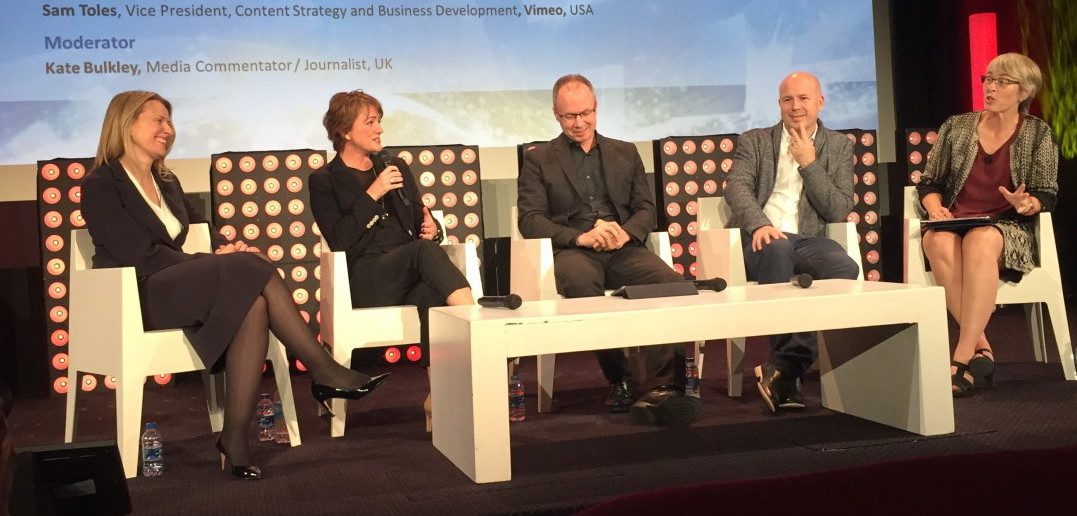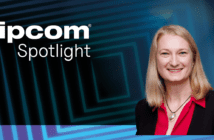In a panel packed with notable distributors, Ericsson revealed some results from its ConsumerLab findings, the fruit of a five-year study they’ve conducted to produce one of the largest ever global studies of TV consumption habits.
1.1 billion people in 40 different countries were surveyed, hailing from 15 different megacities (cities with over 10 million inhabitants). The study totals 100,000 respondents.
The results were followed by a Q&A session moderated by commentator Kate Bulkley (far right). The panel included (left to right) EVP and managing director Susanna Dinnage of Discovery Networks UK & Ireland, CMO Stella Medlicott from Ericsson’s broadcast and media services, BBC director of audiences Nick North, and Sam Toles, VP global content acquisitions and business development at Vimeo.
Medlicott kicked off with Ericsson’s ConsumerLab findings, which benefit from on-device measurement, a measure of what people actually watch. « What we say we’re watching is often not what we’re actually watching, » Medlicott explained. The measurement also compensates for people’s tendency to overstate their streaming viewing and understate linear viewing.
In terms of daily media habits:
– Eight in 10 teens watch streamed on demand TV and video at least once per day.
– Eight in 10 60-69 year-olds watch scheduled linear TV at least once per day.
– 61% of users watch TV and videos on smartphones, a rise of 71% from 2012.
– 42% of respondents find it important to watch TV and video content wherever they are.
– 41% of respondents use YouTube daily; 8% watch over 3 hours per day. « A lot of audiences are watching how-to videos, and the younger demographic are watching gaming content, » Medlicott elaborated.
– 65% of users stream long-form content on demand. This includes programmes and series like Orange is the New Black.
In terms of on-demand viewing, YouTube dominates in both the US and UK. In the US, it enjoys 41% daily views and 71% weekly views from respondents, and is followed by Netflix. Whereas in the UK, it enjoys 37% daily views and 69% weekly views, followed by BBC iPlayer and ITV. (Netflix, which only launched in the UK in 2012, comes in fifth place.)
This means « broadcasters can dominate the streaming channels, as well as linear channels of content, » Medlicott pointed out.
Another piece of good news for broadcast: Piracy is a big issue, but it can be beaten! Spain in particular had « very high levels » of piracy in 2011: « 32% of consumers shared pirated copy; 29% were streaming pirated copy. Those figures reduced to 14% and 16%, respectively, at the same time legitimate providers emerged to provide that content » to users, Medlicott said.
The case was the same in the US: filesharing fell from 8% in 2011 to 2% today.
Binge watching has also become a big aspect of consumers’ lives: 87% binge view at least once a week; 50% binge daily, and only 5% never binge. Generally this is a good thing: « People can actively select how long they want to watch content for, » said Medlicott.
However, she did signal « frustration amongst audiences » for an issue that she feels the industry has failed to address: 85% of users cannot find something to watch at least once a week. « We are now in a state of too much choice and too many options, » which creates user anxiety, she said. When users finally do choose, they feel as though they’ve lost something of equal value in favour of something that may not be quite as satisfying.
Thus they « default »—settle for what they think is less worthy content—several times a day.
Medlicott attributes this to a lack of sophistication among algorithms, which is a huge opportunity for distributors: One in two consumers trust that their current TV service provider handles their personal data securely and responsibly. Millennials most readily accept providing personal information to improve recommendations.
In other words, « The popularity of TV remains strong, » said Medlicott. « More and more people watch great content, and innovation enables them to do that in more ways. As audiences, we just love great content. »
We then moved on to a conversational Q&A, at which time Bulkley asked North of iPlayer what leads him to believe they are serving the audience correctly. « Do they really want to do stuff online, on mobile? » she asked.
« iPlayer is still primarily used as a catch-up service; the content that works best on iPlayer is still big TV content, » said North. « But now we’re creating new, exclusive, premier content to drive audiences to that. A disproportionate number of views come from 16-34s (15%); for under 16s, 10% of their viewing is on demand. »
« We now just think of ourselves as a content company. How we get that content to them is just academic, » Dinnage of Discovery replied. She went on to say that pay TV remains the heart of the business, but that it’s become saturated.
« Free-to-air has become very important, and we’re looking at OTT opportunities. With Eurosport, we’ve acquired a very effective OTT, » she said. « It’s really about catch-up in the last seven days; people still want to see what everyone’s talking about. But there’s a much bigger playing field to play on, for both content owners and consumers. »
Dinnage also said she liked Medlicott’s notion that what we say we do is different from what we actually consume. « We are very carefully measured. In the world of online, things are a little bit more… flexible. We do have measurements in place, but it is very early days. »
Bulkley then turned to Toles of Vimeo to ask how they perceive Ericsson’s data in the context of their business, noting specifically that in the poll, 20% of users said they’d be willing to pay for content, up from 8%.
« I think the age of pre-roll advertising is coming quickly to an end, » said Toles, who, without naming names, referred to YouTube’s recent decision to go from doing both advertising and paid subscriptions, to testing a premium subscription service with no ads. « What they’re telling me is they underpriced it. And it costs twice as much as Netflix! »
He explained, « People are annoyed by advertising. If you’re used to those environments » — ad-free, subscription-based ones like Hulu and Netflix — « and are forced to go back to broadcast, it’s a very disruptive experience. » (And not in a good way.)
Content creators are facilitating this shift, exchanging the promise of big short-term gains for long-term creative control. The creators of High Maintenance, Vimeo’s first original subscription programme, were first offered a deal by FX, and turned it down « because, among other things, their advertisers didn’t like the idea of a guy with a beard. And of course the guy from High Maintenance has a beard. But it’s ridiculous, right? They took a much less favourable economic deal from us in exchange for creative freedom and ownership of the show, » Toles explained.
« Instead of having a linear one-way pipe with big degrees of separation, it is the audience, the creator and the content living in its own small ecosystem. And that is being replicated tens of thousands of times. So vimeo is reaching into the YouTube community and our own community to find creators making premium content and leveling them up. Are users willing to pay for it? We’ve seen that they are. »
But figures tell a better story, so he shared some: « We have grown 300% year-on-year in transactional sales, and it seems to be never-ending. »
Vimeo’s primary audience is between 18-34. Earlier millennials engage most frequently. « If you look at younger millennials and their viewing habits of linear TV, it’s off the cliff, » Toles continued. « It’s not catchup viewing; they’re not catching up with anything. They’re viewing their own world in their own way, with content creators and celebrities that none of you even know about. »
Dinnage agreed. « People want to know what you stand for, what your philosophy is, what you’re about… and we thought, why would anyone care what Discovery stands for? » It’s only recently that Discovery realised it needed to take a hard position on these points. « Everyone gets a day to make the world bigger. You’ve got to mean it; it’s got to be authentic. »
« Authenticity is crucial, » Toles said.
North elaborated on how the audience is getting involved in content curation on iPlayer. « We’re looking at how we can surface great content. We’re taking what the audience is telling us via panels and bringing it to people’s attention. It’s an audience-informed curation role. » For example, their MyBBC programme encourages people to sign in « to bring them a better BBC, whatever that might mean for them, so they can unlock content they might not be aware of. »
Finding the balance between giving people what they want, and helping them discover new things they’ll love, « is the journey we’re on now, » North continued. « What drives value at BBC is not only time spent but also the connections they have across the platforms and devices they use to access BBC. So, recommendations that encourage people to explore more » are becoming really important.
« People are their own best search engine, » Dinnage observed, referring to how people often discover things based on what friends and family are talking about. « I think if you push algorithms to their extreme, you can get algorithmed into a corner unless you’re overlaying people’s behaviour in other levels of their lives on top of that. » It’s not enough to know what they’re watching or not watching; what do they do on the weekend?
When somebody talks a lot about a show and you go « catch up » on it, « that’s not an algorithm, that’s ambassadors. We’re all just great sponges for advertising and promotion, » Dinnage concluded.
Toles said that’s what vimeo is trying to take advantage of with its Staff Picks section. « I’m not as pessimistic about the computer algorithm, » he said. « Look at Spotify and Pandora; curation in music via algorithm has achieved acceptability in the consumer space. Filmed entertainment is a more complicated matrix, but computers and technology move very quickly, so over time that will get better. »
Social media is, in his view, the ultimate form of curation; it provides fuel to launch series and cut through peak television. « You’re going to default to the people you trust to make those recommendations, » he said.
« Technology can bring enormous flexibility but it can be quite lonely as well, » Dinnage countered. « You have all these different forms of experiencing content… but there is really nothing like a TV in the middle of the room to bring people together. There’s room for everything, they’re variously convenient or not, but I think that’s why people pay for good service. »
« Since I’ve been agreeing with you all day, I’ll disagree with you here, » Toles replied. « I think there is a generational difference. The way younger people communicate and socialise is very different » from people closer to his age, he said. « Their socialisation is sharing and liking content on social media. And for folks in my generation it may seem lonely, but it is honestly the way people in that generation engage. »
He finished with an appeal to the audience. « It has been eye opening how different the world is from that perspective. We should take time to ask our kids, the people who are young, what are you watching and why? That’s how you guys are going to learn how to build a strategy for the future. Talk to that generation. They’re very interesting to talk to. »




